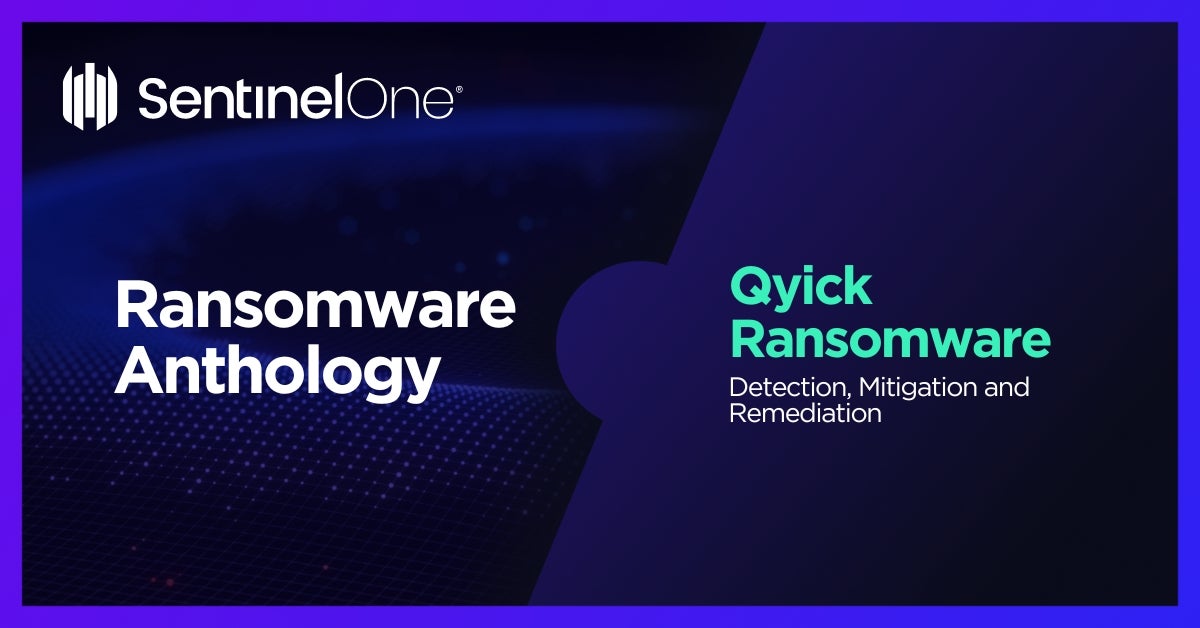Qyick Ransomware: In-Depth Analysis, Detection, and Mitigation
Summary of Qyick Ransomware
In August 2022, the cyber world witnessed the emergence of a new threat: Qyick Ransomware. This malicious software quickly caught the attention of the cybersecurity community for its unique approach – being sold as a Ransomware-as-a-Service (RaaS) on various dark web markets. Its ‘lease’ rates ranged from .2BTC to 1.5BTC, offering various levels of customization for its payloads. What sets Qyick apart is its programming language – it’s developed in Go, known for its efficiency, and it boasts support for multiple encryption modes, including the intriguing ‘intermittent encryption‘.

What Does Qyick Ransomware Target?
Qyick isn’t picky about its victims. It targets a broad spectrum ranging from large enterprises and high-value targets to small and medium businesses (SMBs). The flexibility in its targeting is a direct result of its RaaS model, where affiliates choose their victims based on their own preferences or objectives.
How Does Qyick Ransomware Spread?
Qyick’s distribution channels are as cunning as they are diverse. It primarily spreads through phishing and spear-phishing emails – deceptive communications designed to trick the recipient into installing the ransomware. It also exploits exposed and vulnerable applications and services, and it leverages popular third-party frameworks like Empire, Metasploit, and Cobalt Strike to infiltrate networks.
Qyick Ransomware Technical Details
Late August 2022 saw ‘lucrostm’, a known entity in cybercrime circles, advertising Qyick in a notorious TOR-based crime market. This wasn’t lucrostm’s first rodeo – they were already known for selling remote access tools and malware loaders. Unlike typical RaaS offerings, Qyick was a one-time purchase with a price tag varying from .2 BTC to 1.5 BTC, depending on how tailored the buyer wanted their ransomware. An interesting catch – if the ransomware was detected by security software within six months, the buyer would get a new sample at a significant discount. Qyick’s claim to fame is its intermittent encryption, a technique that accelerates the encryption process, making it a formidable tool for cybercriminals. However, Qyick doesn’t possess data exfiltration capabilities in its current version.
How to Detect Qyick Ransomware
The SentinelOne Singularity XDR Platform stands as a bulwark against Qyick, with its advanced capabilities to detect and thwart the malicious behaviors and artifacts associated with this ransomware.
How to Mitigate Qyick Ransomware
Mitigating the threat posed by Qyick involves employing the SentinelOne Singularity XDR Platform. This platform is adept at identifying and neutralizing the risks associated with Qyick, ensuring your digital environment remains secure.
How to Remove Qyick Ransomware
For those protected by SentinelOne, there’s little to worry about when it comes to Qyick. The platform’s proactive defense mechanisms ensure protection without the need for additional actions. In scenarios where SentinelOne’s policy is set to ‘Detect Only’ and an infection occurs, the platform’s unique rollback capability can reverse the malicious impact and restore encrypted files, as demonstrated in the accompanying video.
Qyick Ransomware FAQs
What is Qyick ransomware?
Qyick ransomware is a malware family that encrypts your files and demands payment for recovery. It’s written in Rust programming language, making it cross-platform compatible. When Qyick infects your system, it will encrypt files and append a unique extension to them. You can identify it by the ransom note it leaves with payment instructions.
How can organizations detect Qyick ransomware?
You can detect Qyick ransomware by monitoring your network for unusual file encryption activities. They will generate alerts when suspicious processes consume high system resources. There are specific indicators like connections to command servers. You should regularly scan for these. Before you dismiss alerts, check file modifications and unusual registry changes.
What preventive measures can be taken against Qyick ransomware?
You can prevent Qyick by implementing regular system updates and patches. They will block vulnerabilities that Qyick exploits. You should use multi-factor authentication on all accounts. If you have email security, configure it to block suspicious attachments. Regular offline backups will protect your data. You should train employees to recognize phishing attempts.
What steps should be taken if infected by Qyick ransomware?
If you find Qyick on your system, you should immediately disconnect the infected machine from the network. They will try to spread to other devices. You can use incident response tools to isolate the attack. If you have backups, prepare them for restoration. You should report the incident to law enforcement.
Is Qyick ransomware still active in 2025?
Qyick ransomware is still active in 2025, with multiple variants appearing since detection. They will continue to evolve their tactics to evade security. You can see updated threat reports confirming recent attacks. If you have to implement defenses, focus on the newest Qyick variants. You should stay updated on the latest indicators of compromise.